This article needs additional citations for verification .(February 2016) |

The following list is a list of festivals in Iran .
This article needs additional citations for verification .(February 2016) |

The following list is a list of festivals in Iran .
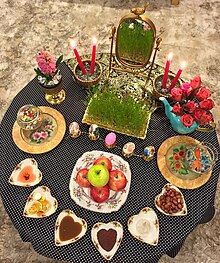
The basis of nearly all of Iranian national festivals are from its Pre-Islamic Zoroastrian era. However, there are some festivals that are celebrated exclusively by Zoroastrians and some with less extent in other communities too.
The majority of Iranian Christians are Armenian-Iranians also known as Parska-Hye who follow the Armenian Apostolic Church, an Oriental Orthodox branch of Christianity. This minority has their very own special festivals and traditions.
There is also a significant minority of Assyrian people who follow the Oriental Orthodox Christian Assyrian Church of the East and the Chaldean Catholic Church, these two church groups also have a minority of Persian followers. The followers of this church have a blend of Persian and Assyrian culture.
Iran has a large and fast growing Christian community gaining popularity amongst Persians. During Christmas times, Christmas trees can be seen from windows in Tehran and north-western provinces. Although Christmas has an official recognition in Iran, it is not a national holiday.
Iranian Jews celebrate all the same holidays as Jews worldwide, but often maintain unique customs in the observance of those holidays. Some more uniquely Iranian traditions include:
Shia Islam is the second-largest branch of Islam. It holds that the Islamic prophet Muhammad designated ʿAlī ibn Abī Ṭālib as his successor (khalīfa) and the Imam after him, most notably at the event of Ghadir Khumm, but was prevented from succeeding Muhammad as the leader of the Muslims as a result of the choice made by some of Muhammad's other companions (ṣaḥāba) at Saqifah. This view primarily contrasts with that of Sunnī Islam, whose adherents believe that Muhammad did not appoint a successor before his death and consider Abū Bakr, who was appointed caliph by a group of Muhammad's other companions at Saqifah, to be the first rightful (rāshidūn) caliph after Muhammad. Adherents of Shīʿa Islam are called Shia Muslims.

Nowruz or Navroz is the Iranian New Year or Persian New Year. Historically, it has been observed by Persians and other Iranian peoples, but is now celebrated by many ethnicities worldwide. It is a festival based on the Northern Hemisphere spring equinox, which marks the first day of a new year on the Solar Hijri calendar; it usually coincides with a date between 19 March and 22 March on the Gregorian calendar.

Qatar observes several public holidays. The two weekend days are Friday and Saturday, similarly to other Islamic countries. Annual public holidays include:
Shaʽban is the eighth month of the Islamic calendar. It is called the month of "separation", as the word means "to disperse" or "to separate" because the pagan Arabs used to disperse in search of water.
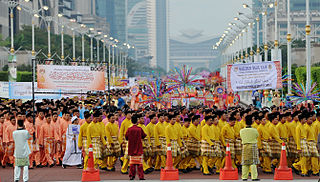
Mawlid, also known as Eid-e-Milad an-Nabi, is an observance of the day when the Islamic prophet Muhammad is reported to have been born. It is commemorated in Rabi' al-Awwal, the third month in the Islamic calendar. 12th Rabi' al-awwal is the accepted date among most of the Sunni scholars, while some Shi'a scholars regard 17th Rabi' al-awwal as the accepted date.

Rajab is the seventh month of the Islamic calendar. The lexical definition of the classical Arabic verb rajaba is "to respect", which could also mean "be awe or be in fear", of which Rajab is a derivative.
This is an alphabetical list of topics related to Islam, the history of Islam, Islamic culture, and the present-day Muslim world, intended to provide inspiration for the creation of new articles and categories. This list is not complete; please add to it as needed. This list may contain multiple transliterations of the same word: please do not delete the multiple alternative spellings—instead, please make redirects to the appropriate pre-existing Wikipedia article if one is present.

There are two official holidays in Islam that are celebrated by Muslims worldwide: Eid al-Fitr and Eid al-Adha. The timing of both holidays are set by the lunar Islamic calendar, which is based upon the cycle of the moon, and so is different from the more common, European, solar-based Gregorian calendar. Every year, the Gregorian dates of the Islamic holidays change.

Mid-Sha'ban is a Muslim holiday observed by Shia and Sunni Muslim communities on the eve of 15th of Sha'ban — the same night as Shab-e-barat or Laylat al-Bara’ah.

Dhu al-Hijjah is the twelfth and final month in the Islamic calendar. Being one of the four sacred months during which war is forbidden, it is the month in which the Ḥajj (Pilgrimage) takes place as well as Eid al-Adha, the “Festival of the Sacrifice.”

Haft Seen or Haft sin is an arrangement of seven symbolic items which names start with the letter "س", the 15th letter in the Persian alphabet; "haft" (هفت) is Persian for "seven". It is traditionally displayed at Nowruz, the Iranian New Year, which is celebrated on the day of the vernal equinox, marking the beginning of spring in the Northern Hemisphere.
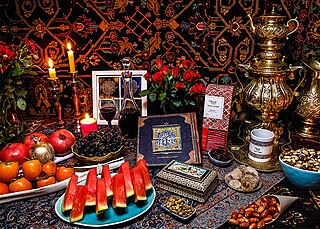
Yaldā Night or Chelle Night is an ancient festival in Iran, Afghanistan, Azerbaijan, Tajikistan, Iraqi Kurdistan, Uzbekistan, Turkmenistan, Dagestan and Turkey that is celebrated on the winter solstice. This corresponds to the night of December 20/21 (±1) in the Gregorian calendar, and to the night between the last day of the ninth month (Azar) and the first day of the tenth month (Dey) of the Iranian solar calendar. The festival is celebrated in Iran and the regions of greater Iran, including Azerbaijan, Iraqi Kurdistan, Balochi areas, Afghanistan and Tajikistan. The longest and darkest night of the year is a time when friends and family gather together to eat, drink and read poetry and Shahnameh until well after midnight. Fruits and nuts are eaten and pomegranates and watermelons are particularly significant. The red color in these fruits symbolizes the crimson hues of dawn and the glow of life. The poems of Divan-e Hafez, which can be found in the bookcases of most Iranian families, are read or recited on various occasions such as this festival and Nowruz. Shab-e Yalda was officially added to Iran's List of National Treasures in a special ceremony in 2008.
Lists of holidays by various categorizations.
Omar Koshan, also known as Jashn-e Hazrat-e Zahra, is a yearly festival held by some Twelver Shi'i Muslims in Iran. Originally, the festival commemorated the assassination of the second caliph Umar ibn al-Khattab by the Persian slave Abu Lu'lu'a Firuz.
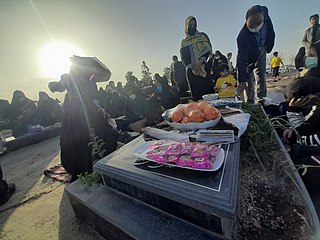
Shab-e-Barat, Cheragh-e-Barat, Berat Kandili, or Nisfu Syaaban is a Mid-Sha'ban related cultural celebration celebrated in many South Asian, Central Asian, South East Asian and Middle Eastern Muslim countries, on the 15th night of the month of Sha'ban, the eighth month of the Islamic calendar.
The Khalafiyya Shia were a subsect of the Zaidi branch of Shia Islam.
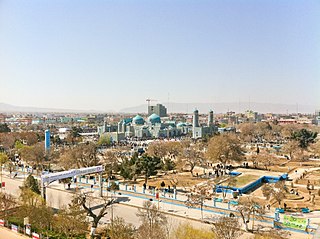
Nowruz is the beginning of springtime and a cultural holiday in Afghanistan. It is also celebrated by the majority of the Afghan diaspora around the world. Farmer's Day, which starts around the same time as the Afghan New Year, is celebrated nationwide alongside Nowruz and usually lasts around two weeks. Among other things, the celebration involves planting saplings and flowers throughout the country.

Eid al-Ghadir is an Islamic commemorative holiday, and is considered to be among the significant holidays of Shi'ite Muslims. The Eid is held on 18 Dhul-Hijjah at the time when the Islamic prophet Muhammad was said to have appointed Ali ibn Abi Talib as his successor. According to Shia hadiths, this Eid has been named "Eid-e Bozorg-e Elāhi", "Eid Ahl al-Bayt Muhammad" and Ashraf al-A'yaad.

The Shrine of Abu Lu'lu'a, also known as the Shrine of Bābā Shujāʿ al-Dīn is a mausoleum built over what is popularly believed to be the final resting place of Abu Lu'lu'a Firuz, a Persian slave who assassinated the second Islamic caliph Umar ibn al-Khattab in 644.